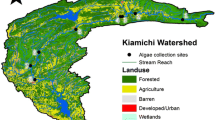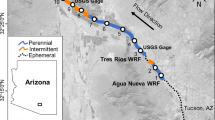Abstract
Intensification of catchment land use often adversely affects ecosystem health in rivers and estuaries via changes to physicochemistry and ecosystem functioning, but whether such land-use effects differ along a freshwater-marine continuum has not been studied. We investigated relationships between intensity of land use and two measures of ecosystem function in freshwater, estuarine and near-marine habitats. Standardized bioassays to determine cellulose breakdown (cotton and canvas strips) and algal accrual rates (ceramic tiles) were deployed in 10 river-to-marine continua whose catchment areas ranged from 2.6 to 99.6% developed. Using general linear models and an information-theoretic approach to select the best predictive models for our response variables, we found that higher dissolved phosphorus concentrations, linked with highly developed catchments, were associated with greater rates of cellulose decomposition (both tensile strength loss and mass loss). Furthermore, after controlling for the contribution of phosphorus or salinity, decomposition rates in freshwater and near-marine habitats generally responded curvilinearly to catchment development, indicating the involvement of additional unmeasured, land-use-related physicochemical or biological variables. The strength and shape of relationships between percentage developed land area and algal biomass accrual rates also contrasted among freshwater (strongest, curvilinear), mid-estuary (intermediate, positive), and near-marine sites (weakest, no obvious shape). Because land-use intensity can influence ecosystem functioning along the entire continuum from streams and rivers to estuaries and coasts, resource managers should adopt an integrated approach to decisions affecting catchment land use.



Similar content being viewed by others
References
Aiken LS, West SG. 1991. Multiple regression: testing and interpreting interactions. Newbury Park: SAGE.
APHA. 1999. Standard methods for the examination of water and wastewater. 20th edn. Washington, DC: American Public Health Association.
Biggs BJF. 1996. Patterns in benthic algae of streams. In: Stevenson RJ, Bothwell ML, Lowe RL, Eds. Algal ecology: freshwater benthic ecosystems. San Diego, CA: Academic Press. p 31–56.
Biggs BJF. 2000. Eutrophication of streams and rivers: dissolved nutrient–chlorophyll relationships for benthic algae. J North Am Benthol Soc 19:17–31.
Biggs BJF, Kilroy C. 2000. Stream periphyton monitoring manual. Christchurch: NIWA Publishing.
Bowen JL, Valiela I. 2001. The ecological effects of urbanization of coastal watersheds: historical increases in nitrogen loads and eutrophication of Waquoit Bay estuaries. Can J Fish Aquat Sci 48:1489–1500.
Bricker SB, Longstaf B, Dennison W, Jones A, Boicourt K, Wicks C, Woerner J. 2008. Effects of nutrient enrichment in the nation’s estuaries: a decade of change. Harmful Algae 8:21–32.
Burnham KP, Anderson DR. 2001. Kullback–Leibler information as a basis for strong inference in ecological studies. Wildl Res 28:111–19.
Chew I, Obbard JP, Stanforth RR. 2001. Microbial cellulose decomposition in soils from a rifle range contaminated with heavy metals. Environ Pollut 111:367–75.
Clapcott JE, Young RG, Goodwin EO, Leathwick JR. 2010. Exploring the response of functional indicators of stream health to land-use gradients. Freshw Biol 55:2181–99.
Dauer DM, Ranasinghe JA, Weisberg SB. 2000. Relationships between benthic community condition, water quality, sediment quality, nutrient loads, and land use patterns in Chesapeake Bay. Estuaries 23:80–96.
Edgar GJ, Barrett NS. 2000. Effects of catchment activities on macrofaunal assemblages in Tasmanian estuaries. Estuar Coast Shelf Sci 50:639–54.
Flynn DFB, Gogol-Prokurat M, Nogeire T, Molinari N, Trautman Richers B, Lin BB, Simpson N, Mayfield MM, DeClerck F. 2009. Loss of functional diversity under land use intensification across multiple taxa. Ecol Lett 12:22–33.
Frutiger A, Meier Buergisser G. 2002. Life history variability of a grazing stream insect (Liponeura cinerascens minor; Diptera: Blephariceridae). Freshw Biol 47:1618–32.
Gessner MO, Chauvet E. 2002. A case for using litter breakdown to assess functional stream integrity. Ecol Appl 12:498–510.
Graham AA. 1988. The impact of fine silt on epilithic periphyton, and possible interactions between periphyton and invertebrate consumers. Verh Int Ver Theor Angew Limnol 23:1437–40.
Hagen EM, Webster JR, Benfield EF. 2006. Are leaf breakdown rates a useful measure of stream integrity along an agricultural landuse gradient? J N Am Benthol Soc 25:330–43.
Harraway JA. 1995. Regression methods applied. Dunedin: University of Otago Press.
Heggie K, Savage C. 2009. Nitrogen yields from New Zealand coastal catchments to receiving estuaries. NZ J Marine Freshwat Res 43:1039–52.
Hemminga MA, de Leeuw J, de Munck W, Koutstaal BP. 1991. Decomposition in estuarine salt marshes: the effect of soil salinity and soil water content. Vegetation 94:25–33.
Hildrew AG, Townsend CR, Francis J, Finch K. 1984. Cellulolytic decomposition in streams of contrasting pH and its relationship with invertebrate community structure. Freshw Biol 14:323–8.
Imberger SJ, Thompson RM, Grace MR. 2010. Searching for effective indicators of ecosystem function in urban streams: assessing cellulose decomposition potential. Freshw Biol 55:2089–106.
Kemp WM, Boynton WR, Adolf JE, Boesch DF, Boicourt WC, Brush G, Cornwell JC, Fisher TR, Glibert PM, Hagy JD, Harding LW, Houde ED, Kimmel DG, Miller WD, Newell RIE, Roman MR, Smith EM, Stevenson JC. 2005. Eutrophication of Chesapeake Bay: historical trends and ecological interactions. Marine Ecol Prog Ser 303:1–29.
Kinney EL, Valiela I. 2011. Nitrogen loading to Great South Bay: land use, sources, retention, and transport from land to bay. J Coast Res 27:672–86.
Larned ST, Scarsbrook MR, Snelder TH, Norton NJ, Biggs BJF. 2004. Water quality in low-elevation streams and rivers of New Zealand: recent state and trends in contrasting land-cover classes. NZ J Marine Freshwat Res 38:347–66.
Lopes ML, Martins P, Ricardo F, Rodrigues AM, Quintino V. 2011. In situ experimental decomposition studies in estuaries: a comparison of Phragmites australis and Fucus vesiculosus. Estuar Coast Shelf Sci 92:573–80.
Matthaei CD, Weller F, Kelly DW, Townsend CR. 2006. Impacts of fine sediment addition to tussock, pasture, dairy and deer farming streams in New Zealand. Freshw Biol 51:2154–72.
Meeuwig JJ. 1999. Predicting coastal eutrophication from land-use: an empirical approach to small non-stratified estuaries. Marine Ecol Prog Ser 176:231–41.
Mendelssohn IA, Slocum MG. 2004. Relationship between soil cellulose decomposition and oil contamination after an oil spill at Swanson Creek, Maryland. Marine Pollut Bull 48:359–70.
Mendelssohn IA, Sorrell BK, Brix H, Schierup HH, Lorenzen B, Maltby E. 1999. Controls on soil cellulose decomposition along a salinity gradient in a Phragmites australis wetland in Denmark. Aquat Bot 64:381–98.
Ministry for the Environment. 2008. http://www.mfe.govt.nz/issues/land/land-cover-dbase. Accessed 1 March 2008.
NIWA. 2008. http://www.niwa.co.nz/our-science/freshwater/tools/rec. Accessed 1 March 2008.
Niyogi DK, Koren M, Arbuckle CJ, Townsend CR. 2007. Stream communities along a catchment land-use gradient: subsidy-stress responses to pastoral development. Environ Manage 39:213–25.
Paerl HW. 2009. Controlling eutrophication along the freshwater-marine continuum: dual nutrient (N and P) reductions are essential. Estuaries Coasts 32:593–601.
Piscart C, Genoel R, Doledec S, Chauvet E, Marmonier P. 2009. Effects of intense agricultural practices on heterotrophic processes in streams. Environ Pollut 157:1011–18.
Quinn GP, Keough MJ. 2002. Experimental design and data analysis for biologists. Cambridge: Cambridge University Press.
Quinn JM, Stroud MJ. 2002. Water quality and sediment and nutrient export from New Zealand hill-land catchments of contrasting land use. NZ J Marine Freshwat Res 36:409–29.
Quinn JM, Davies-Colley RJ, Hickey CW, Vickers ML. 1992. Effects of clay discharges on streams. 2. Benthic invertebrates. Hydrobiologia 248:235–47.
Richards S, Whittingham M, Stephens P. 2011. Model selection and model averaging in behavioural ecology: the utility of the IT-AIC framework. Behav Ecol Sociobiol 65:77–89.
Roache MC, Bailey PC, Boon PI. 2006. Effects of salinity on the decay of the freshwater macrophyte, Triglochin procerum. Aquat Bot 84:45–52.
Schallenberg M, Larned ST, Hayward S, Arbuckle C. 2010. Contrasting effects of management opening regimes on water quality in two intermittently closed and open coastal lakes. Estuar Coast Shelf Sci 86:587–97.
Schindler DW. 2006. Recent advances in the understanding and management of eutrophication. Limnol Oceanogr 51:356–63.
Slocum MG, Roberts J, Mendelssohn IA. 2009. Artist canvas as a new standard for the cotton-strip assay. J Plant Nutr Soil Sci 172:71–4.
Smithwick EAH, Kashian DM, Ryan MG, Turner MG. 2009. Long-term nitrogen storage and soil nitrogen availability in post-fire lodgepole pine ecosystems. Ecosystems 12:792–806.
Sponseller RA, Benfield EF. 2001. Influences of land use on leaf breakdown in southern Appalachian headwater streams: a multiple-scale analysis. J N Am Benthol Soc 20:44–59.
Thrush SF, Hewitt JE, Cummings VJ, Ellis JI, Hatton C, Lohrer A, Norkko A. 2004. Muddy waters: elevating sediment input to coastal and estuarine habitats. Front Ecol Environ 2:299–306.
Tiegs SD, Langhans SD, Tockner K, Gessner MO. 2007. Cotton strips as a leaf surrogate to measure decomposition in river floodplain habitats. J N Am Benthol Soc 26:70–7.
Townsend CR, Uhlmann SS, Matthaei CD. 2008. Individual and combined responses of stream ecosystems to multiple stressors. J Appl Ecol 45:1810–19.
Wagenhoff A. 2011. Multiple-stressor effects along gradients of deposited fine sediment and dissolved nutrients in streams. Ph.D. Thesis, University of Otago, New Zealand.
Wagenhoff A, Townsend CR, Phillips N, Matthaei CD. 2011. Multiple-stressor effects along gradients of deposited fine sediment and dissolved nutrients in streams. Freshw Biol 56:1916–36.
Walsh CJ, Roy AH, Feminella JW, Cottingham PD, Groffman PM, Morgan RP. 2005. The urban stream syndrome: current knowledge and the search for a cure. J N Am Benthol Soc 24:706–23.
Wood PJ, Armitage PD. 1997. Biological effects of fine sediment in the lotic environment. Environ Manage 21:203–17.
Young RG. 2006. Functional indicators of river ecosystem health—results from regional case studies of leaf decomposition. Cawthron Report No. 1054. Prepared for the Ministry for the Environment, New Zealand. http://www.cawthron.org.nz/coastal-freshwater-resources/downloads/case-study-report-final.pdf. Accessed 22 Sept 2007.
Young RG, Collier KJ. 2009. Contrasting responses to catchment modification among a range of functional and structural indicators of river ecosystem health. Freshw Biol 54:2155–70.
Young RG, Matthaei CD, Townsend CR. 2008. Organic matter breakdown and ecosystem metabolism: functional indicators for assessing river ecosystem health. J N Am Benthol Soc 27:605–25.
Acknowledgments
We thank Antoine Baehr, Nicky McHugh, Gregory Stanley, Joanne Clapcott, Amélie Saunier, Yannick Pons, and Beate Bierschenk. A. M. Bierschenk was supported by a University of Otago Ph.D. scholarship. The comments of Daniel Schindler and two anonymous reviewers resulted in substantial improvements to this manuscript.
Author information
Authors and Affiliations
Corresponding author
Additional information
Author Contributions
Candida Savage, Colin R. Townsend, Christoph D. Matthaei conceived of or designed study, Antje M. Bierschenk performed the research. Antje M. Bierschenk, Candida Savage, Colin R. Townsend, Christoph D. Matthaei analyzed the data. Antje M. Bierschenk, Candida Savage, Colin R. Townsend, Christoph D. Matthaei contributed new methods or models. Antje M. Bierschenk, Candida Savage, Colin R. Townsend, Christoph D. Matthaei wrote the paper.
Rights and permissions
About this article
Cite this article
Bierschenk, A.M., Savage, C., Townsend, C.R. et al. Intensity of Land Use in the Catchment Influences Ecosystem Functioning Along a Freshwater-Marine Continuum. Ecosystems 15, 637–651 (2012). https://doi.org/10.1007/s10021-012-9536-0
Received:
Accepted:
Published:
Issue Date:
DOI: https://doi.org/10.1007/s10021-012-9536-0




